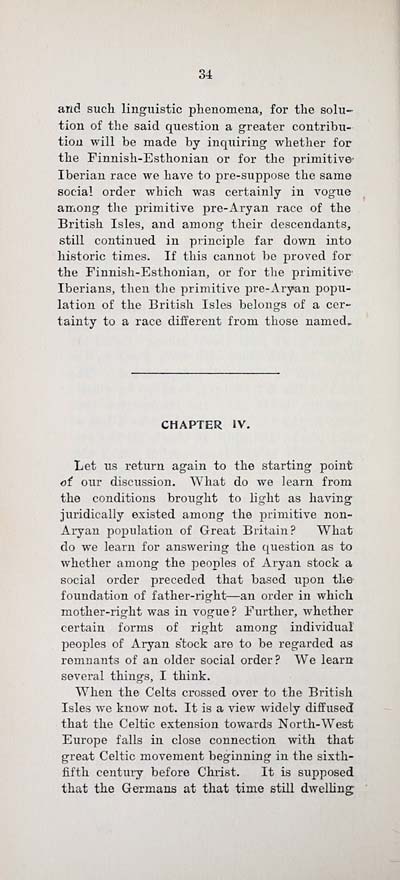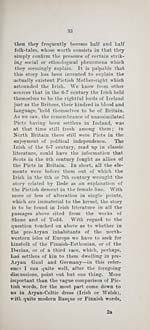Download files
Complete book:
Individual page:
Thumbnail gallery: Grid view | List view

34
arid such linguistic phenomena, for the solu-
tion of tlie said question a greater contribu-
tion will be made by inquiring whether for
the Finnish-Esthonian or for the primitive-
Iberian race we have to pre-suppose the same
social order which was certainly in vogue
among tlie primitive pre-Aryan race of the
British Isles, and among their descendants,
still continued in principle far down into
historic times. If this cannot be proved for
the Finnish-Esthonian, or for the primitive
Iberians, then the primitive pre-Aryan popu-
lation of the British Isles belongs of a cer-
tainty to a race different from those named.
CHAPTER IV,
Let us return again to the starting point
of our discussion. What do we learn from
the conditions brought to light as having
juridically existed among the primitive non-
Aryan population of Great Britain? What
do we learn for answering the question as to
whether among the peoples of Aryan stock a
social order preceded that based upon the
foundation of father-right— an order in which
mother-right was in vogue? Further, whether
certain forms of right among individual
peoples of Aryan s'tock are to be regarded as
remnants of an older social order? We learn
several things, I think.
When the Celts crossed over to the British
Isles we know not. It is a view widely diffused
that the Celtic extension towards North-West
Europe falls in close connection with that
great Celtic movement beginning in the sixth-
fifth century before Christ. It is supposed
that the Germans at that time still dwelling
arid such linguistic phenomena, for the solu-
tion of tlie said question a greater contribu-
tion will be made by inquiring whether for
the Finnish-Esthonian or for the primitive-
Iberian race we have to pre-suppose the same
social order which was certainly in vogue
among tlie primitive pre-Aryan race of the
British Isles, and among their descendants,
still continued in principle far down into
historic times. If this cannot be proved for
the Finnish-Esthonian, or for the primitive
Iberians, then the primitive pre-Aryan popu-
lation of the British Isles belongs of a cer-
tainty to a race different from those named.
CHAPTER IV,
Let us return again to the starting point
of our discussion. What do we learn from
the conditions brought to light as having
juridically existed among the primitive non-
Aryan population of Great Britain? What
do we learn for answering the question as to
whether among the peoples of Aryan stock a
social order preceded that based upon the
foundation of father-right— an order in which
mother-right was in vogue? Further, whether
certain forms of right among individual
peoples of Aryan s'tock are to be regarded as
remnants of an older social order? We learn
several things, I think.
When the Celts crossed over to the British
Isles we know not. It is a view widely diffused
that the Celtic extension towards North-West
Europe falls in close connection with that
great Celtic movement beginning in the sixth-
fifth century before Christ. It is supposed
that the Germans at that time still dwelling
Set display mode to: Large image | Transcription
Images and transcriptions on this page, including medium image downloads, may be used under the Creative Commons Attribution 4.0 International Licence unless otherwise stated. ![]()
| Early Gaelic Book Collections > Hew Morrison Collection > Leabhar Nan Gleann > (46) |
|---|
| Permanent URL | https://digital.nls.uk/76888393 |
|---|
| Description | A selection of items from a collection of 320 volumes and 30 pamphlets of literary and religious works in Scottish Gaelic. From the personal library of Hew Morrison, the first City Librarian of Edinburgh. |
|---|
| Description | Selected items from five 'Special and Named Printed Collections'. Includes books in Gaelic and other Celtic languages, works about the Gaels, their languages, literature, culture and history. |
|---|

